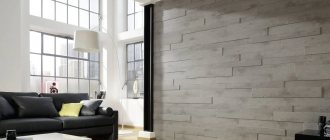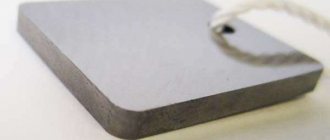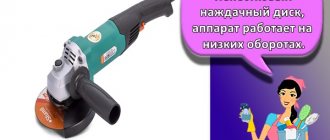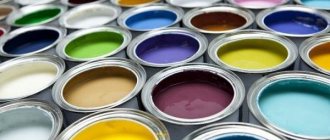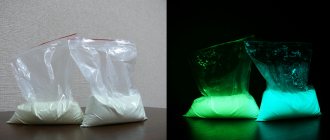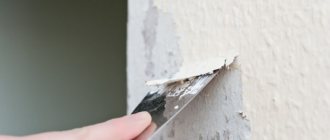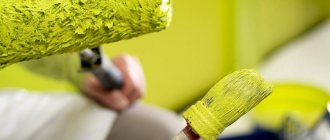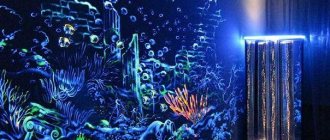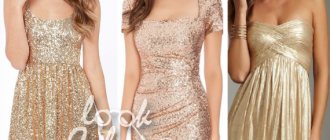Those who are faced with painting work may have problems choosing a colorant. The types of paints are so varied that it is difficult to choose the right option. Each option can be used for one or another job. The surface and area of use play a big role. We will look at some selection rules, and also consider in detail all types of paints and varnishes.
Features of the compositions
The main difference between the compositions is their scope of application. Products are:
- for internal use. Suitable only for painting interior surfaces where it will not be subject to aggressive influence;
- for outdoor use. It copes well with factors such as ultraviolet radiation, excess moisture, wind and other atmospheric influences. The cost of trains is higher.
Advice! To understand what kind of paint is in front of you, just look at the packaging. It indicates whether it is external or internal.
The main task of the dye is to protect and decorate the surface being treated. A film is created on the surface that protects it from rain, dust, corrosion and ultraviolet radiation. The base is a coloring pigment. It is he who is responsible for the color of the paint and varnish product. The more pigment, the brighter and more saturated the paint. Thanks to modern technologies, products with a matte or glossy effect are created.
Types of paint and varnish products are divided depending on the main component. There are 6 main groups:
- Emulsion.
- Alkyd.
- Silicate.
- Adhesive.
- Facade.
- Special paints.
Each option has its own characteristics.
Some more useful tips
- It is better to add thinner to the paint in the proportion indicated on the packaging (indicated as a percentage). If there is too much paint, the properties of the paint may change - wear resistance and coverage will deteriorate, the degree of gloss will change, and marks from the roller or brush will remain on the surface itself.
- It is better to apply a second coat of paint after the first has completely dried. Drying speed is affected by factors such as humidity, temperature, and air movement.
(Total: 1 , average 5.00 out of 5)
Loading…
Emulsion compositions
A special feature of emulsion compositions is that they are diluted with water. Thanks to this, they have many advantages:
- Once dry, it is difficult to wash off.
- She is not afraid of moisture.
- Dries quickly.
- Does not have any strong unpleasant odors.
- Resistant to alkali.
- It is easy to wash off before it dries. Anyone can work with emulsion products.
- Affordable price.
- Safe for humans.
Note! Various finishing materials can be applied to the emulsion base. But the emulsion itself cannot be applied to glossy or adhesive paint.
Emulsion paints are divided into the following subtypes:
- water-emulsion, water-dispersion;
- acrylic;
- latex;
- polyvinyl acetate;
- silicone.
Water-emulsion and water-dispersion
Their common property is excellent adhesion without peeling from the surface. The paint and varnish material breathes, air currents and air vapors pass through it. Features of the compositions:
- An ideal solution for rooms with high humidity. Used indoors, not frost-resistant. But the color is retained for a long time.
- Matte water-based compositions cannot boast of color stability. The range of shades is rich, however, they wash off over time.
- The paint is flexible, which allows the master to create complex patterns on the walls.
- Water-dispersible varieties can be washed frequently. Italian products have become famous for their high resistance to washing.
- Recommended application conditions: temperature +5 °C and above.
The range of goods is very large. You can choose the right option for any interior.
Acrylic
The binder is acrylic resins. Thanks to acrylic, the products are elastic, which makes working with wooden surfaces easier. Peculiarity:
- When applied, acrylic-based paint material can close small cracks. The paint copes with a crack thickness of 0.5 mm.
- When the composition dries, it becomes frost-resistant, so it can protect surfaces made of reinforced concrete, etc.
- Since its gas permeability is low, acrylic compositions for plaster should be used after a month. During this time, the plaster will completely harden.
Advice! Despite its excellent resistance to mechanical stress, it is not recommended to use the material for damp walls.
Latex
From the name it is clear that the main component is latex. The main difference is the high price. But the resulting film after drying ideally protects the surface from moisture. Peculiarities:
The property of latex paint is demonstrated by water entering the apartment after rain.
- Hides cracks and defects, the thickness of which is 1 mm. After drying, the surface can be washed repeatedly using alkali.
- Latex paint can be applied to concrete, brick, plaster and drywall. It dries quite quickly. Application of the second layer is allowed after 15–20 minutes.
- There is no heavy odor, so working with the material is easy. True, the light resistance of the latex type is worse than that of its acrylic counterpart.
- The main feature is the formation of a mirror-smooth, silky matte surface with a special shine.
- Water is used as a solvent. If, when painting, drops fall on another surface, they can be removed with a damp cloth or napkin.
Polyvinyl acetate
The most inexpensive and environmentally friendly compounds. They are often used for ceilings. It does not become dirty, so there is no need to clean the surface. Frequent washing of such products is not recommended. Some of the material will be washed away. But its resistance to ultraviolet radiation is excellent.
Silicone
Due to the presence of emulsified silicone resin in the composition, silicone products have excellent water-repellent properties. Peculiarities:
- The resulting film is capable of permeating air and steam. The composition is elastic and can hide cracks and defects up to 2 mm in size.
- You can apply it to plaster after 2-3 days, not a month. The painted surface can withstand wet cleaning.
- The downside is the high cost of production.
These were representatives of emulsion paints. Many craftsmen prefer to use these particular compositions for interior decoration.
Paints by type of binder
Let's take a closer look at the details of the type of binder.
Oily
Oils are made from drying oil, natural or synthetic. In addition to drying oil, the composition may include a coloring pigment and filler. Thickly grated and ready-to-use oil paints are produced. Thickly grated ones require dilution with drying oil to the desired consistency before painting. Drying oil can be made from sunflower, hemp or linseed oil. In terms of the quality of the resulting coating, materials based on sunflower drying oils are inferior to those based on hemp and linseed drying oils.
In addition to natural drying oil, combined drying oils and “oxol” are used in oil substances, which are made from a mixture of different oils that have undergone special processing. They can be diluted with solvents. Combined drying oils include the following types:
- polymerized (LMS) is a substitute for natural drying oil, can be used in paints for both interior and exterior use;
- glyphthalic drying oil consists of a mixture of vegetable oil, glycerin, solvents;
- pentaphthalic drying oil is made from alkyd resins;
- synthol, carbonol, etc. are artificial drying oils in which there is either no natural vegetable oil at all, or there is, but a minimal amount. The quality of the product on such drying oils is significantly inferior to oil paints on natural drying oil or oxol.
Calcareous and silicate
They are also called mineral, as natural substances are used for production. The most common is the usual, familiar lime. To obtain a specific color, an alkali-resistant pigment is added to lime milk. Typically, lime materials are used to paint the exterior surfaces of a building. It is recommended to paint moistened surfaces with this solution in cool weather. Lime paint is not highly resistant compared to perchlorovinyl substances, but the price of lime is much lower.
Portland cement-based materials are also classified as mineral. They are produced ready-to-use and require only dilution with water immediately before use, since the cement included in the composition quickly hardens in the open air. It is recommended to paint with this solution in two layers over a damp base. When vermiculite is added to the composition, a rough textured surface is obtained, familiar under the name “fur coat” or “shagreen”.
Silicate paints, included in the list of mineral paints, are made from liquid potassium glass, chalk, talc, fine sand, and pigments. They are produced in two-component formulations - dry material and liquid glass, which are mixed immediately before application to the surface. But before this, you need to treat the surface with liquid glass primer.
All mineral paints are suitable for painting concrete, brick, wood and other porous external surfaces. Their use is not recommended for painting glass or smooth metal surfaces.
Alkyd
They are made on the basis of alkyd resin, which is obtained by processing vegetable oils with the addition of acids and dryers. Used for painting both inside and outside. Diluted with solvents and drying oil. Compared to water-based emulsion, alkyd is more durable. But the persistent smell after painting does not allow it to be used in rooms where there are children and people susceptible to various allergic diseases.
Water-based
This type of paint has gained wide popularity in recent decades due to its non-toxicity, good hiding power, and a wide selection of substrates to be painted. Today, this type of paint is the most environmentally friendly type of finishing materials, which is confirmed by its use even when painting walls on staircase corridors.
The only place where it is not recommended to use water-dispersion paint is on metal substrates, so as not to cause metal corrosion from interaction with water. Paints of this type are produced on the basis of PVA (polyvinyl acetate emulsion), on the basis of latexes and acrylics. The materials are used for painting porous surfaces, but require preliminary priming. They are diluted with water and dry quickly. Despite the fact that the composition contains water, after painting a film is formed on the surface, which can be wiped with a damp sponge; in addition, the film has high vapor and air permeability properties.
PVA-based material is not highly resistant to moisture. For painting facades and interior spaces with high humidity, it is better to use materials based on acrylic and latexes.
Acrylic
This type of paint belongs to the latex family, which includes, in addition to acrylic:
- polyviniacetate;
- acrylic silicone;
- styrene acrylic;
- acrylic butadiene styrene.
Acrylic materials have a wide range of applications from painting various plasterboard surfaces to concrete and brick surfaces. A variety of latex paints allows you to paint wallpaper, giving it a new look, plaster, foam concrete and much more. The film formed on the painted base lends itself well to wet cleaning, it is resistant to washing off, dirt and dust, as well as various midges, do not stick to it.
Silicone
Manufactured based on water and silicone resin. These latest developments in the world of decorative coatings make it possible to paint almost any surface, with the exception of reinforced concrete, since air penetrates into the concrete body and causes corrosion of the reinforcement. Silicone paints have absorbed all the best that is found in silicate and acrylic paints. By painting with silicone material you can close cracks up to 2 mm wide. This type of paint can be combined with different paint compositions. That is, silicone paint can be used to cover old surfaces previously painted with cement and lime compositions, as well as water-based and latex ones. The material can be used for decorative finishing, i.e. for both interior and exterior work. But its cost is so high that it reduces the popularity of its use.
Polyurethane and epoxy
Most are intended for industry. If polyurethane paint dries at a temperature of +180-200 degrees, then there is no point in talking about its use in construction.
Epoxy is a two-component composition and is also used mainly in industry. In construction, it can be used when constructing concrete pools or when repairing enamel baths.
Alkyd paints and varnishes
No less popular is the type made on the basis of alkyd resin. The composition is ideal for painting metal products, wood and plastered walls. Features of alkyd paints:
- They are waterproof.
- They have an affordable price.
- Easy to apply to the surface.
- Disadvantages include toxicity during drying and an unpleasant odor. After painting, you should not stay in the room for several days. In addition, the paints are not as resistant to UV rays and are not durable enough.
Types of alkyd products:
- oil;
- enamel.
Oil compositions are based on drying oil. Paint thinner is gasoline, white spirit or turpentine. This makes them quite dangerous. When painting, it is recommended to protect the respiratory tract. Oil products take a long time to dry, releasing harmful substances. Recommended for outdoor use. Over time, the paint will turn yellow from the sun.
But enamel paints and varnishes dry quickly and are not as toxic as their oil-based counterparts. After processing, a beautiful glossy surface is obtained. The composition is used for interior and exterior decoration. Metal products (sinks, bathtubs, toilets, pipes), as well as plastered wooden walls, are often painted with enamel.
Alkyd types of paints used
Non-toxic paints with an alkyd resin base. They are not afraid of water, ultraviolet radiation, and are suitable for work indoors and outdoors. Divided into 2 types:
- Oily. Compositions based on drying oil. Dissolves with organic solvents. They take a long time to dry, releasing toxic substances.
- Enamel. Paints with a varnish base that gives surfaces a glossy finish. They are distinguished by high waterproofness and resistance to ultraviolet radiation, and versatility. Suitable for painting different types of surfaces.
Alkyd paints are in demand for indoor and outdoor work. Used for painting coatings that experience increased mechanical loads (floors, steps).
Silicate compounds
The main component of the paint is liquid glass. Thanks to it, the paint has excellent properties. It allows air and steam to pass through, withstands temperature changes and has low sensitivity to water. Water is used to dilute the product.
The peculiarity of the application is that the composition is used to treat walls that have not previously been treated with an alkyd or acrylic composition. And even after using silicate material, changing to another type will entail difficulties.
Note! The dye is made with various additives, such as glitter, which will make the room original.
What types of paints are not recommended to be used and where?
Silicate paints are not used for painting metal and polymer surfaces due to the almost zero adhesion of liquid glass to these materials. They are also not recommended for surfaces previously painted with organic dyes.
Alkyd compositions are not recommended for residential (especially children's) premises due to low vapor permeability, strong odor and easy flammability.
water-dispersed ones in poorly heated rooms due to possible waterlogging and mold formation. Not suitable for surfaces previously painted with gloss, adhesive or varnish compositions.
Adhesive paints do not tolerate high humidity and carbon dioxide concentrations, becoming moldy under such conditions.
We reviewed the main types and properties of paints that are most in demand on the paint and coatings market. When choosing paint, you should pay attention to the scope of application and compliance with operating conditions. Also, the new coating must be compatible with the old surface coating and not enter into undesirable reactions with it. But the most important thing is that the paint should be as safe as possible for human health.
Adhesive compositions
When creating, organic polymers are used that are dissolved in water. In terms of their properties, adhesive paints are close to emulsion paints. Only they cannot boast of moisture resistance. It is recommended to use them for enclosed spaces. Comes from the manufacturer in dry form. Before use, the composition is diluted with water.
Types of adhesive paints:
- Casein. Used for both interior and exterior work. They are the most stable and beautiful. After application, a high-quality coating is formed on concrete, plaster and brick.
- Dextrinated. Since the composition contains bone glue, the water resistance of the paint and varnish material is low. That is why they are used exclusively for interior work.
- Adhesive paints. A special feature is a wide selection of colors, environmental friendliness and ease of application. True, there are drawbacks - the adhesive composition is not resistant to high moisture. If there is insufficient air flow in the room, mold and other harmful microorganisms may appear on the surface. This reduces the service life.
Adhesive paints: types and applications
Water-based compositions with organic fillers. The characteristics are largely similar to emulsion paints. Recommended as one of the types of paints in rooms with normal humidity levels. Divided into 2 types:
- Casein. The most durable of adhesives, can be used for external painting of concrete, brick or plastered surfaces.
- Dextrinated. Based on bone glue, does not tolerate moisture well, recommended for interior work.
Available in the form of a dry powder, soluble in water. They are gradually being forced out of the paint and varnish market.
Facade
Since there are special requirements for outdoor use, special façade products have been created. It has increased resistance to atmospheric influences and a number of other advantages:
- the material does not fade or lose its color when exposed to ultraviolet rays;
- has mechanical stability and is not afraid of rain and snow. All requirements are met for any coating: wood, concrete, metal or brick;
- Manufacturers produce silicate, acrylic or silicone paint for facades, which differs from compositions for interior use;
- their ductility is better, as is adhesion to the surface;
- the compositions are not afraid of temperature changes and severe frosts.
On the shelves you can find facade paints and varnishes that combine the best qualities of acrylic and silicate options. After processing, a film appears that protects the surface from moisture.
Paint for walls in an apartment
Paint and varnish products are classified depending on the composition and characteristics of the layer formed. These parameters are paid attention first and then they look at the price. Only the right approach to choosing paint for walls in an apartment will ensure longevity and an attractive appearance in the room.
Only the right approach to choosing paint for walls in an apartment will ensure longevity and an attractive appearance in the room.
Advantages and disadvantages of painting walls
To decide whether wall paint is a suitable finishing option for each specific interior, you need to understand the features. Benefits include:
- Ease of finishing. You don't need any special skills to apply it. The room turns out to be very neat due to the formation of a seamless surface;
- The surface is not exposed to ultraviolet radiation, so no fading occurs;
- Wall paint is easy to maintain. The surface is treated with a damp cloth;
- It’s easy to “refresh” a renovation, just as it’s easy to give the interior a new look. It is enough to choose a new shade or texture and apply a new layer to the walls;
- The palette allows you to realize any designer's ideas. It is only important to select the remaining interior elements that match the color of the walls;
- If you use decorative painting, you can get a highly aesthetic, modern interior design that will have individual features.
If you use decorative painting, you can get a highly aesthetic, modern interior design.
Despite such obvious advantages, this type of finishing also has disadvantages:
- You cannot choose this method if the wall has defects and unevenness;
- Painted surfaces quickly become dirty;
- Such rooms, especially children's rooms and kitchens, will have to be cleaned frequently to get rid of dirt. At the same time, cleaning products are carefully selected so that their chemical components do not react with paint and varnish materials and do not cause unwanted stains or any other changes in color and structure;
- Preliminary work must be performed according to technological rules. It is important to prepare the walls or ceiling for painting - they must be smooth. Otherwise, in the presence of micro-irregularities and roughness, paint peeling will be observed during operation;
- Wall paint is not resistant to moisture and temperature changes. If this condition is not met, then over time it begins to peel off. The interior takes on an unpresentable appearance.
Such rooms, especially children's rooms and kitchens, will have to be cleaned frequently to get rid of contamination.
Special paints
It also happens that a room requires the use of special-purpose paint. Such compositions have additional properties that protect the surface. For example, this is anti-vandal or non-flammable paint. There are several options for special paints:
- Anti-corrosion. It is used only for metal surfaces. After treatment, the product will not rust and will last much longer. You can paint fences without removing rust from them.
- Bactericidal, fungicidal paints. Used exclusively for wood. Wood can rot and become moldy. To prevent this, special bactericidal compounds are used.
- Paints that eliminate imperfections. You can easily deal with unevenness, cracks, and minor defects with it. After processing, a flat, smooth and beautiful surface is obtained.
Special formulations are used exclusively for a specific purpose.
Dye markings with interpretation
In accordance with current Russian standards (GOST 9825-73), a combination of 2 letters of the Cyrillic alphabet and 2-4 Arabic numerals separated by a dash is used for marking paint and varnish products.
Information about what type of paint the paint belongs to is always indicated on the packaging.
For example, code PF-155 indicates:
- PF – pentaphthalic base material;
- 1 – weather resistance;
- 15 – composition with serial number 15 (assigned when creating enamel).
Additional information on components is available in certification documents or GOST standards (applies to Russian-made products). The type of paint and varnish material (for example, enamel, primer) is always indicated before the code. For a number of materials, a letter indicating the type is placed in front of the digital combination (B - without solvents, V - water-based or VD - water-dispersed compositions, O - organic-dispersive and P - powder). If an additional identifier is introduced, it is separated from neighboring groups by dashes.
Common encodings of the base base for construction or repair enamels (for both external and internal work):
- PA – polyamide;
- PC – polyacrylate;
- AC – based on copolymer compounds of polyacrylic;
- AC – cellulose acetate;
- BT – bitumen;
- VA – polyvinyl acetate;
- VL – polyvinyl butyral;
- VN – vinyl or vinyl acetate;
- GF – glypthal;
- ZhS – containing alkali metal silicates (liquid glass);
- KK – based on natural resin (rosin);
- UR – polyurethane;
- KCh – rubber;
- NC – nitrocellulose;
- PF – pentaphthalic;
- FM – phenolic-oil;
- EC – ethylcellulose.
To indicate the primary purpose, digital codes are used:
- 0 – primers and varnishes, semi-finished products for the production of other paints and varnishes;
- 00 – putty (regardless of purpose);
- 1 – weather resistant;
- 2 – intended for indoor use (limited weather resistance);
- 3 – allowing preservation of metal structures;
- 4 – resistant to hot water and steam;
- 5 – designed for application to fur or leather products or having specific properties (for example, resistance to x-ray radiation);
- 6 – resistant to petroleum products (motor oil or fuel);
- 7 – intended for painting structures operating in aggressive environments (acids or alkalis and their vapors);
- 8 – resistant to temperature influences;
- 9 – having electrical insulating properties.
The Russian standard allows for the designation of the type of drying oil that is included in the material:
- 1 – natural;
- 2 – oxol;
- 3 – glyphthalic;
- 4 – pentaphthalic;
- 5 – combined.
Imported paints and varnishes are marked in accordance with regional and international standards. There are Russian designations with fewer numbers in the code. For example, the MA-25 index indicates an oil-based enamel (MA) intended for interior use (2), containing a combined drying oil. The designation always indicates the shade of the material (for example, red-brown or blue).
For proper use of paint, it is important for the consumer to know what the markings on the label or special insert mean.
When there is a wide variety of options, colors are indicated with an additional numerical identifier (for example, yellow-1 or yellow-2, the number indicates the shade). The standard allows the shade to be specified in accordance with the sample file with the introduction of a code in the database (for example, gray 571).
Due to the large number of designation options, it is difficult for a novice painter to understand the types of enamels, so it is recommended to contact a store consultant or invite an experienced selection specialist.
Some tips for choosing
Types of paints are varied. They were created for certain conditions. Below are the requirements that are important to adhere to before purchasing:
- For rooms where people stay for a long time, it is better to use breathable paints. Water-dispersed and acrylic compositions are suitable.
- Bathroom, kitchen, utility room are wet rooms. The paint must withstand moisture. It is recommended to use compounds that form a dense film that will protect the surface.
- The nursery is treated only with a water-dispersion composition. No toxins, only environmentally friendly substances.
- As for color, residents make their own choice. Light colors are suitable for bedrooms, children's rooms are decorated with bright colors, the kitchen and living room are optional, depending on the interior design.
Types of varnishes and paints for interior work
For this group, environmental friendliness and human safety come to the fore. They must also be vapor-permeable (otherwise condensation will form under the paint layer), moisture-resistant (maintain their appearance after wet treatment), and resistant to abrasion and fading (ultraviolet).
The best types of paints for indoor walls:
- silicone;
- latex;
- structural;
- acrylic;
- silicate.
The latter type is the most budget-friendly with fairly high quality characteristics. Applying silicate paint requires skill, and the downside is that it takes a long time to dry.

